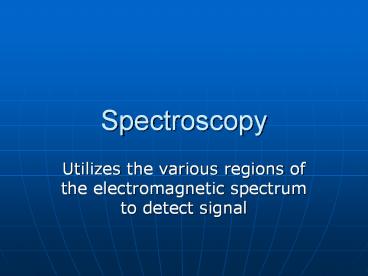Spectroscopy - PowerPoint PPT Presentation
Title:
Spectroscopy
Description:
Spectroscopy Utilizes the various regions of the electromagnetic spectrum to detect signal Different regions Different Regions Spectroscopy Utilizes the various ... – PowerPoint PPT presentation
Number of Views:196
Avg rating:3.0/5.0
Title: Spectroscopy
1
Spectroscopy
- Utilizes the various regions of the
electromagnetic spectrum to detect signal
2
Different regions
UV results from changes in bonding e- UV
spectroscopy
X-rays result from inner e- transitions x-ray
powder diffraction
g rays result from nuclear transitions
Scintillation counting, g ray emission,
radioactive assays, and DNA fingerprinting
Visible also from bonding e- transitions visible
spectroscopy
Visible also from bonding e- transitions visible
spectroscopy
3
Different Regions
IR results from vibration and rotation of
molecules IR and Raman spectroscopy
Radio results from spin of nuclei in magnetic
field NMR
Microwave results from rotation of molecules
microwave absorption and e- spin resonance
4
- Frequency of oscillations to the field per
second - Wavelength Distance between any 2 equal points
on wave - Wavenumber 1/l n
5
- Transmittance
- T P/Po
- Where Po initial power of beam
- P power of beam passing through sample
- T P/Po x 100
- A -logT
A ebc
The thicker the glass the darker the brew, the
less the light that shines through































